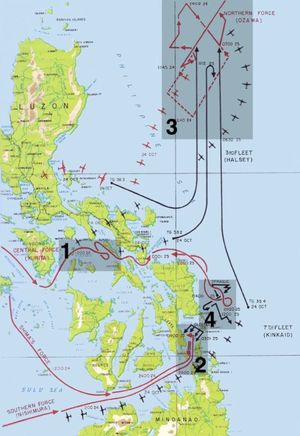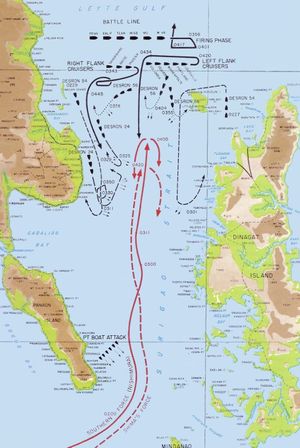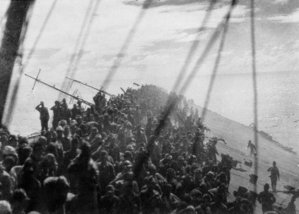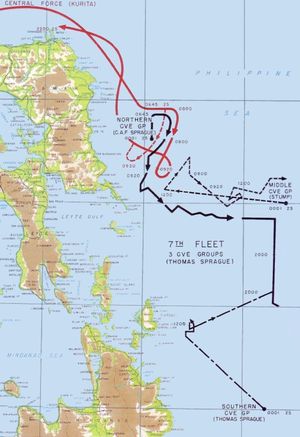Battle of Leyte Gulf
2007 Schools Wikipedia Selection. Related subjects: World War II
| Battle of Leyte Gulf | |||||||
|---|---|---|---|---|---|---|---|
| Part of World War II, Pacific War | |||||||
 USS Princeton on fire, east of Luzon, 24 October 1944. |
|||||||
|
|||||||
| Combatants | |||||||
various others |
|||||||
| Commanders | |||||||
| Strength | |||||||
| 17 aircraft carriers 18 escort carriers 12 battleships 24 cruisers 141 destroyers and destroyer escorts Many PT boats, submarines and fleet auxiliaries About 1,500 planes |
4 aircraft carriers 9 battleships 19 cruisers 34 destroyers About 200 planes |
||||||
| Casualties | |||||||
| 3,500 dead; 1 aircraft carrier, 2 escort carriers, 2 destroyers, 1 destroyer escort sunk |
10,000 dead; 4 aircraft carriers, 3 battleships, 8 cruisers, 12 destroyers sunk |
||||||
| Philippines campaign, 1944-45 |
|---|
| Leyte – Leyte Gulf – Ormoc Bay – Mindoro – Lingayen Gulf – Luzon – Cabanatuan – Bataan – Manila – Corregidor – Los Baños – Palawan – Visayas – Mindanao |
The Battle of Leyte Gulf the largest naval battle in recent history. It was fought during the Pacific War of World War II, in the seas surrounding the Philippine island of Leyte from 23 October to 26 October 1944 between the Allies and the Empire of Japan. The Japanese attempted to repel or destroy the Allied forces stationed on Leyte after the preceding Allied invasion in the Battle of Leyte. Instead, the Allied navies inflicted a major defeat on the outnumbered Imperial Japanese Navy which took away Japan's strategic force in the Pacific War. The battle was the last major naval engagement of World War II.
Leyte Gulf also saw the first use of kamikaze aircraft by the Japanese. The Australian heavy cruiser HMAS Australia was hit on 21 October, and organized suicide attacks by the "Special Attack Force" began on 25 October.
Strategic background
The battles of 1943 had driven the Imperial Japanese Army from its bases in the Solomon Islands, and in 1944, a series of Allied amphibious landings supported by large carrier forces captured the Northern Mariana Islands. The Allied victory in the Battle of the Philippine Sea in June destroyed the Japanese carrier power and established Allied air and sea superiority over the Western Pacific. (Japanese airmen were not well trained due to Japan's loss of her expierienced pilots. American airmen found it so easy to shoot down the Japanese that they nicknamed the air battle "The Great Marianas Turkey Shoot".)
This gave the Allies freedom to choose where to strike next. Admiral Chester Nimitz favored blockading Japanese forces in the Philippines and attacking Formosa (now Taiwan). Possession of Formosa would give the Allies control of the sea routes to Japan from southern Asia, severing Japan's links with its garrisons, which would then perish from lack of supplies. General Douglas MacArthur favoured an invasion of the Philippines, which also lay across the supply lines to Japan. Leaving the Philippines in Japanese possession would be a blow to American prestige, and a personal affront to MacArthur, who in 1942 had famously vowed to return. President Franklin Roosevelt adjudicated the dispute; he chose the Philippines.
The Allied options were equally apparent to the Imperial Japanese Navy. Combined Fleet Chief Toyoda Soemu prepared four "victory" plans: Shō-Go 1 (捷1号作戦 Shō ichigō sakusen) was a major naval operation in the Philippines, while Shō-Go 2, Sho-Go 3 and Sho-Go 4 were responses to attacks on Formosa, the Ryūkyū Islands and the Kurile Islands respectively. The plans were uncompromising, complex, aggressive operations committing all available forces to a decisive battle.
Thus, when on 12 October 1944, Nimitz launched a carrier raid against Formosa to make sure that planes based there could not intervene in the Leyte landings, the Japanese put Shō-Go 2 into action, launching wave after wave of attacks against the carriers, losing 600 planes in three days, almost their entire air force (or what was left of it), and leaving the Japanese navy without air cover.
Shō-Go 1 called for Vice-Admiral Jisaburo Ozawa's fleet, known as Northern Force, to lure the U.S. 3rd Fleet away from the landings using an apparently vulnerable force of carriers. The Allied landing forces, now lacking air cover, would then be attacked from the west by three Japanese forces: Vice-Admiral Takeo Kurita's command, Centre Force, based in Brunei, would enter Leyte Gulf and destroy the Allied landing forces. Rear-Admiral Shoji Nishimura's and Vice-Admiral Kiyohide Shima's fleets, collectively called Southern Force, would act as mobile strike forces. All three forces would consist of surface ships.
The plan was likely to result in the destruction of one or more of the forces, but Toyoda later justified it to his American interrogators as follows:
- Should we lose in the Philippines operations, even though the fleet should be left, the shipping lane to the south would be completely cut off so that the fleet, if it should come back to Japanese waters, could not obtain its fuel supply. If it should remain in southern waters, it could not receive supplies of ammunition and arms. There would be no sense in saving the fleet at the expense of the loss of the Philippines.
Overview of the battle
The battle consisted of four large, distinct engagements. Before these was a small strike by American submarines. See the map to the right.
- On the night of 23 October, two American submarines, Italic textDaceItalic text and Italic textDarterItalic text spotted Kurita's Center Force entering the Palawan Passage. The two subs submerged and fired torpedos, sinking two cruisers and crippling a third. One of the sinking cruisers was the flagship of Center Force. Admiral Kurita swam for his life. Centre Force was in chaos for hours, before Kurita was finally rescued. Kurita transferred his flag to the super-battleship Italic textYamatoItalic text. The order was then given to continue on to Leyte Gulf.
- Kurita's force entered the Sibuyan Sea, northwest of Leyte, on 24 October. In the Battle of the Sibuyan Sea it was attacked by carrier aircraft and Musashi was sunk. When Kurita turned around, the American pilots thought he was retreating, but he turned again and made his way through the San Bernardino Strait in the night, to appear off Samar in the morning.
- Nishimura's fleet headed for the Surigao Strait to the south, where at 03:00 on 25 October it ran into an American battlegroup. In the Battle of Surigao Strait the Japanese battleships Fusō and Yamashiro were sunk, Nishimura was killed, and his surviving ships retreated west.
- Halsey learned of the approach of Ozawa and took the bait, taking his carriers in pursuit on 25 October. In the Battle off Cape Engaño four Japanese carriers were sunk by air attacks. Ozawa's surviving ships fled for Japan.
- Kurita arrived off Samar at about 06:00 on 25 October. With Halsey away in pursuit of Ozawa, the American vessels supporting the landing were vulnerable to daylight attack. But in the Battle off Samar, desperate American destroyer torpedo attacks, relentless air attacks and bad weather bluffed Kurita into turning back.
Battle of the Sibuyan Sea
Kurita's powerful "Centre Force" consisted of five battleships ( Yamato, Musashi, Nagato, Kongō, and Haruna), and twelve cruisers ( Atago, Maya, Takao, Chōkai, Myōkō, Haguro, Noshiro, Kumano, Suzuya, Chikuma, Tone, and Yahagi), supported by thirteen destroyers.
As Kurita passed Palawan Island shortly after midnight on October 23, his force was spotted by the submarines USS Dace and Darter. Although the submarines' report of the sighting was picked up by the radio operator on Yamato, the Japanese failed to take anti-submarine precautions. Kurita's flagship Atago was sunk by Darter and Maya by Dace. Kurita transferred his flag to Yamato. Takao was damaged and turned back to Brunei with two destroyers, shadowed by the submarines. On October 24, Darter grounded on the Bombay Shoal. All efforts to get her off failed, and she was abandoned; her entire crew was rescued by Dace.
At about 08:00 on October 24, the force was spotted entering the narrow Sibuyan Sea by planes from USS Intrepid. 260 planes from carriers Intrepid and Cabot of Task Group 38.2 attacked at about 10:30, scoring hits on Nagato, Yamato, Musashi and severely damaging Myōkō. The second wave of planes concentrated on Musashi, scoring many direct hits with bombs and torpedoes. As she retreated, listing to port, a third wave from Enterprise and Franklin hit her with eleven bombs and eight torpedoes. Kurita turned his fleet around to get out of range of the planes, passing the crippled Musashi as he retreated. He waited until 17:15 before turning around again to head for the San Bernardino Strait. Musashi finally rolled over and sank at about 19:30.
Meanwhile, Vice Admiral Onishi Takijiro had directed his First Air Fleet of 80 planes based on Luzon against the carriers Essex, Lexington, Princeton and Langley of Task Group 38.3 (whose planes were being used to attack airfields in Luzon to prevent Japanese land based aircraft attacks on the Allied ships in the Leyte Gulf). Princeton was hit by an armour-piercing bomb and burst into flames. At 15:30, the aft magazine exploded, killing 200 sailors on Princeton and 80 on the cruiser Birmingham which was alongside assisting with the firefighting. Birmingham was so badly damaged that she was forced to retire, and other nearby vessels were damaged too. All efforts to save Princeton failed, and she sank at 17:50.
Battle of Surigao Strait
Nishimura's "Southern Force" consisted of the battleships Yamashiro and Fusō, the cruiser Mogami, and four destroyers. They were attacked by bombers on October 24 but sustained only minor damage.
Because of the strict radio silence imposed on the Central and Southern Forces, Nishimura was unable to synchronise his movements with Shima and Kurita. When he entered the narrow Surigao Strait at about 02:00 Shima was 40 km behind him, and Kurita was still in the Sibuyan Sea, several hours from the beaches at Leyte.
As they passed the cape of Panaon Island, they ran into a deadly trap set for them by the 7th Fleet Support Force. Rear Admiral Jesse Oldendorf had six battleships ( Mississippi, Maryland, West Virginia, Tennessee, California, and Pennsylvania, all but the Mississippi having been resurrected from Pearl Harbour), eight cruisers ( heavy cruisers USS Louisville (Flagship), Portland, Minneapolis and HMAS Shropshire, light cruisers USS Denver, Columbia, Phoenix, Boise), 29 destroyers and 39 PT boats. To pass the strait and reach the landings, Nishimura would have to run the gauntlet of torpedoes from the PT boats, evade two groups of destroyers, proceed up the strait under the concentrated fire of six battleships in line across the far mouth of the strait, and then break through the screen of cruisers and destroyers.
At about 03:00, Fusō and the destroyers Asagumo, Yamagumo, and Mishishio were hit by torpedoes launched by the destroyer groups. Fusō broke in two, but did not sink. Then at 03:50, the battleships opened fire. Radar fire control allowed American battleships to hit targets from a distance at which the Japanese could not reply. Yamashiro and Mogami were crippled by 16-inch (406 mm) armour-piercing shells. Shigure turned and fled, but lost steering and stopped dead. Yamashiro sank at 04:19.
At 04:25, Shima's two cruisers ( Nachi and Ashigara) and eight destroyers reached the battle. Seeing what they thought were the wrecks of both Nishimura's battleships (actually the two halves of Fusō), he ordered a retreat. His flagship, Nachi, collided with Mogami, flooding the latter's steering-room. Mogami fell behind in the retreat and was sunk by aircraft the next morning. The bow half of Fusō was destroyed by Louisville and the stern half sank off Kanihaan Island. Of Nishimura's seven ships, only Shigure survived.
Yamashiro was the last battleship to engage another in combat, and one of very few to have been sunk by another battleship. The battle itself was the last in naval history to take place solely between all-gun warships. This was also the last battle in which one force (the Americans, in this case) was able to cross the T of its opponent, enabling the US ships to bring all their firepower to bear on the Japanese ships.
Battle off Cape Engaño
Ozawa's "Northern Force" had four aircraft carriers ( Zuikaku — the last surviving carrier of the Attack on Pearl Harbour — Zuihō, Chitose, and Chiyoda), two World War I battleships partially converted to carriers ( Hyūga and Ise — the aft turrets had been replaced by hangar, deck and catapult, but neither carried any planes in this battle), three cruisers ( Ōyodo, Tama, and Isuzu), and nine destroyers. He had only 108 planes.
Ozawa's force was not spotted until 16:40 on October 24, because the Americans were too busy attacking Kurita and dealing with the air strikes from Luzon. On the evening of October 24, Ozawa intercepted a (mistaken) American communication of Kurita's withdrawal, and began to withdraw as well. But at 20:00, Toyoda Soemu ordered all forces to attack.
Halsey saw that he had an opportunity to destroy the last Japanese carrier forces in the Pacific, a blow that would completely destroy Japanese sea power and allow the U.S. Navy to attack the Japanese homelands. Believing that Kurita had been defeated by the airstrikes in the Sibuyan Sea, and was retiring to Brunei, Halsey set out in pursuit of Ozawa just after midnight with all three carrier groups and the battleships of Admiral Willis A. Lee's Task Force 34. In so doing, Halsey or members of his staff ignored reports from scout planes from the USS Independence that Kurita had turned back towards San Bernardo Strait and that the navigation lights in the strait had been turned on. When Admiral G.F. Bogan, commanding TF 38.2, radioed this information to Halsey's flagship, he was rebuffed by a staff officer, who replied "Yes, yes, we have that information." Admiral Willis A. Lee, who had correctly recognized that Ozawa's force was a decoy and indicated the same in a blinker message to Halsey's ship, was similarly rebuffed.
The U.S. Third Fleet was formidable and completely outgunned the Japanese Northern Force. Halsey had nine fleet carriers ( Intrepid, Hornet, Franklin, Lexington, Bunker Hill, Wasp, Hancock, Enterprise, and Essex), eight light carriers ( Independence, Princeton, Belleau Wood, Cowpens, Monterey, Langley, Cabot, and San Jacinto), six battleships ( Alabama, Iowa, Massachusetts, New Jersey, South Dakota, and Washington), seventeen cruisers and sixty-three destroyers. He could put more than 1,000 planes in the air. But it left the landings on Leyte covered only by a handful of escort carriers and destroyers.
Halsey had taken the bait so temptingly dangled in front of him by Ozawa; fittingly, the engagement was to take place off a cape whose name means "deceit" in Spanish.
On the morning of October 25, Ozawa launched 75 planes to attack the Americans, doing little damage. Most of the planes were shot down by the American covering patrols. A handful of survivors made it to Luzon.
The American carriers launched their first attack group of 180 aircraft at dawn, before the Northern Force had been located. The search aircraft made contact at 7:10. At 8:00, the American fighters destroyed the defensive screen of 30 aircraft. Air strikes began and continued until the evening, by which time the American aircraft had flown 527 sorties against the Northern Force, sinking three of Ozawa's carriers (Zuikaku, Zuihō and Chiyoda) and the destroyer Akitsuki. The fourth carrier, Chitose, was disabled, as was the cruiser Tama. Ozawa transferred his flag to Ōyodo.
With all the Japanese carriers sunk or disabled, the main targets remaining were the converted battleships Ise and Hyūga. Their massive construction proved resistant to the air strikes, so Halsey sent Task Force 34 forward to engage them directly. But then news reached Halsey of the engagement off Samar and the disaster facing Sprague's Task Group 77.4. He abandoned the pursuit and turned south, detaching only a small force of cruisers and destroyers under Laurence T. DuBose to sink the disabled Japanese ships. Ise and Hyūga returned to Japan, where they were sunk at their moorings in 1945.
Battle off Samar
Kurita passed through San Bernardino Strait at 03:00 on 25 October 1944 and steamed south along the coast of Samar.
To stop them, there were three groups of the Seventh Fleet commanded by Admiral Thomas Kinkaid, each with six escort carriers, and seven or eight destroyers and/or destroyer escorts. Admiral Thomas Sprague's Task Unit 77.4.1 ("Taffy 1") consisted of the escort carriers Sangamon, Suwannee, Santee, and Petrof Bay. (The remaining two escort carriers from Taffy 1, Chenango and Saginaw Bay, had departed for Morotai, Indonesia on October 24, carrying "dud" aircraft from other carriers for transfer ashore. They returned with replacement aircraft after the battle.) Admiral Felix Stump's Task Unit 77.4.2 ("Taffy 2") consisted of Natoma Bay, Manila Bay, Marcus Island, Kadashan Bay, Savo Island, and Ommaney Bay. Admiral Clifton Sprague's Task Unit 77.4.3 ("Taffy 3") consisted of Fanshaw Bay, St Lo, White Plains, Kalinin Bay, Kitkun Bay, and Gambier Bay. Each escort carrier carried about 30 planes, making more than 500 planes in all. Escort carriers were slow and lightly armoured and stood little chance in an encounter with a battleship.
A mix-up in communications led Kinkaid to believe that Willis A. Lee's Task Force 34 of battleships was guarding the San Bernardino Strait to the north and that there would be no danger from that direction. But Lee had gone with Halsey in pursuit of Ozawa. The Japanese came upon Taffy 3 at 06:45, taking the Americans completely by surprise. Kurita mistook the escort carriers for fleet carriers and thought that he had the whole of the American Third Fleet under the 18 inch (457 mm) guns of his battleships.
Clifton Sprague (no relation to Thomas Sprague) directed his Taffy 3 carriers to turn and flee towards a squall to the east, hoping that bad visibility would reduce the accuracy of Japanese gunfire, and sent his destroyers in to distract the Japanese battleships and buy time. The destroyers attacked the Japanese line with suicidal determination, drawing fire and scattering the Japanese formations as ships turned to avoid torpedoes. Yamato found herself between two torpedoes on parallel courses and for ten minutes, she headed away from the action, unable to turn back for fear of being hit. The American destroyers Hoel and Johnston, and destroyer escort Samuel B. Roberts were sunk and four others were damaged, but they had bought enough time for Sprague to launch planes from all three Taffy groups. There was no time to reload with armour-piercing bombs, so the planes attacked with whatever they happened to be carrying, (in some cases with depth charges). According to Morison, many aircraft, their ordnance expended, made dry runs against the Japanese warships.
Taffy 3 turned south and fled with shells falling around its carriers. Gambier Bay, bringing up the rear, was holed, slowed, then sunk, and most of the others were hit and damaged. The small carriers returned fire with the only guns they had, their single stern-mounted five-inch (127mm) anti-aircraft guns. These weapons, loaded solely with anti-aircraft shells, had little chance of inflicting significant damage on even unarmored surface ships. St. Lo scored a hit, to date the only known hit inflicted directly by an aircraft carrier (as opposed to by its aircraft) on an opposing surface vessel.
It seemed impossible for Taffy 3 to escape total destruction, and the Japanese force also began firing on the other two Taffy groups as they were able to close the range with their superior speed, but at 09:20, Kurita suddenly turned and retreated north. The air and destroyer attacks had broken up his formations, he had lost tactical control, and the heavy cruisers ( Chōkai, Suzuya, Chikuma) had been sunk by concentrated sea and air attack. Signals from Ozawa had disabused him of the notion that he was attacking the whole of the 3rd Fleet, which meant that the longer he continued to engage, the more likely it was that he would suffer devastating air strikes from Halsey's carriers. He retreated north and then west through the San Bernardino Strait under continuous air attack. Nagato, Haruna and Kongō were severely damaged. He had begun the battle with five battleships; when he returned to Japan, only Yamato remained combat-worthy.
Aftermath
The battle of Leyte Gulf secured the beachheads of the U.S. Sixth Army on Leyte against attack from the sea. However, much hard fighting would be required before the island was completely in Allied hands at the end of December 1944: the Battle of Leyte on land was fought in parallel with an air and sea campaign in which the Japanese reinforced and resupplied their troops on Leyte while the Allies attempted to interdict them and establish air-sea superiority for a series of amphibious landings in Ormoc Bay — engagements collectively referred to as the Battle of Ormoc Bay.
The Battle of Leyte Gulf destroyed Japanese naval power and opened the way for the advance to the Ryūkyū Islands in 1945. The only significant Japanese naval operation for the rest of the war was the disastrous Operation Ten-Go in April 1945.
As the battle was coming to an end, Vice Admiral Takijiro Onishi put his "Special Attack Force" into operation, launching kamikaze attacks against the Allied ships in Leyte Gulf. On 25 October, Australia was hit for a second time and forced to retire for repairs, while the escort carrier St. Lo was sunk.
Criticism of Halsey
Halsey was criticized for his decision to take Task Force 34 with him in pursuit of Ozawa, and for failing to dispatch it when Kinkaid first appealed for help. US Navy slang for Halsey's action has ever since been Bull's Run, a neologism combining Halsey's nickname "Bull" and the Battles of the Bull Run in the American Civil War. In his dispatch after the battle, he justified the decision as follows:
- Searches by my carrier planes revealed the presence of the Northern carrier force on the afternoon of 24 October, which completed the picture of all enemy naval forces. As it seemed childish to me to guard statically San Bernardino Strait, I concentrated TF 38 during the night and steamed north to attack the Northern Force at dawn. I believed that the Centre Force had been so heavily damaged in the Sibuyan Sea that it could no longer be considered a serious menace to Seventh Fleet.
Clifton Sprague, commander of Task Unit 77.4.3 in the battle off Samar, was later critical of Halsey's decision:
- In the absence of any information that this exit [of the San Bernardino Strait] was no longer blocked, it was logical to assume that our northern flank could not be exposed without ample warning.
Naval historian Samuel Morison wrote:
- If TF 34 had been detached a few hours earlier, after Kinkaid's first urgent request for help, and had left the destroyers behind, since their fueling caused a delay of over two hours and a half, a powerful battle line of six modern battleships under the command of Admiral Lee, the most experienced battle squadron commander in the Navy, would have arrived off San Bernardino Strait in time to have clashed with Kurita's Centre Force… Apart from the accidents common in naval warfare, there is every reason to suppose that Lee would have crossed Kurita's T and completed the destruction of Centre Force.
A message from Nimitz asking for the location of Task Force 34 led to ill-feeling between him and Halsey, owing to a misunderstood piece of security padding (see " the world wonders").








